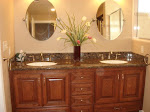In my last post, I discussed color schemes and aspects of the color wheel. This time I will discuss how to use color to tackle your decorating challenges. The right color can make a large room seem more intimate, a small room seem more spacious, and even fool the eye into thinking that a narrow room is wider or that a low ceiling is higher.
If your room is very small, with little natural light, and you’d like to make it seem as large as possible, choose a light, cool color and paint everything—walls, ceiling, doors, even trim-- in that color. Flooring material should also be in a similar color, for instance a light maple hardwood, or a light-colored carpet. Tile installed on the diagonal will draw your eye into the room and visually make the room seem larger. Minimize the contrasts in the room for a spacious feel, so upholstery and window treatments also should be in a similar color. Add interest with textures and tone-on-tone patterns. Add a few sparks of color with artwork and accessories.
Some of us have small rooms, but rather than make them feel spacious, prefer to accentuate their coziness. A recent re-design client of mine described her small home as a “jewel box”. She chose rich colors such as caramel for her walls, green for her sofa and chocolate-colored leather for her side chair. With accents of gold and burgundy, her room exuded a warm, welcoming charm.
To make a large room seem smaller, choose darker warm colors, such as the caramel, green, and burgundy mentioned above. To increase the coziness, add a variety of colorful patterns and textures on upholstery, pillows and window treatments. A large area rug with a dark-colored border will also help to bring in the walls and create the appearance of a smaller room.
A monochromatic color scheme in cool, restful colors such as gray-blue or mossy green will create a calm and peaceful feeling in a room. Minimize the contrasts in the room by repeating the same color in fabrics and window treatments. On the other hand, a three-color scheme, emphasizing warmer colors and incorporating vibrant patterns in fabric, accessories and art will create a lively, vibrant mood in the space.
To make a long, narrow room seem wider, your objective is to visually extend the walls outward. To do this, paint the two opposite long walls in a light, cool color, and paint the short walls in a darker shade of the same color. Limit the number of patterns and colors in the room. If your aim is to make the long, narrow room seem shorter, use a darker color on the opposite long walls, possibly even a patterned wall covering, and a lighter shade of the same color on the short walls.
To make your ceiling appear higher, paint a border on the ceiling using the wall color. Trim the border in a darker color, and use a lighter color on the ceiling inside the border. In contrast, to bring down a high ceiling, use a darker color than the walls, and paint a border on the walls in the same color. Trim the border in a contrasting color, or use a wallpaper border. One of the easiest ways to change the look and feel of a room is with color. Happy Decorating!
Monday, June 9, 2008
Subscribe to:
Posts (Atom)






